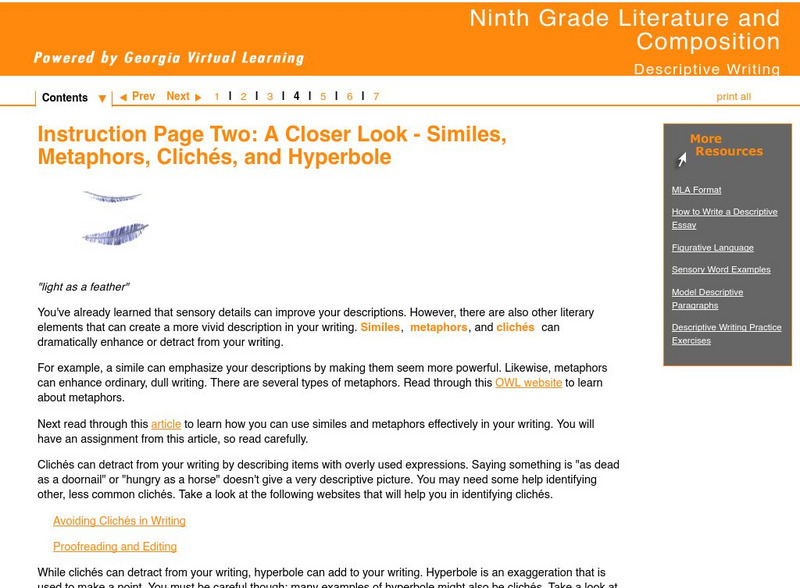Hi, what do you want to do?
Curated OER
Push or Pull
Students examine a large box and determine how they may move the box to a specified point. After the class makes predictions, they test them and decide what worked and what didn't work. Through their tests, push and pull are introduced....
Curated OER
The Life and Times of....
Students assume the role of an investigative reporter and research an artist and the world in which they worked. They create a 2-page newspaper using MS Publisher about the artist and the time period he/she lived in.
Curated OER
Curiosity Shop
First graders simulate shopping for needs and wants. For this money lesson, 1st graders examine Norman Rockwell's painting "Curiosity Shop." Students role-play shopping in a store and making purchases.
Curated OER
Sand and Water
Students follow this recipe for fun clay creations. In this early childhood art and science lesson, students develop creative-thinking skills, fine-motor skills, and sensory awareness while they make, mold, and decorate salt dough.
Curated OER
Animal: Unique Creatures With Great Features
Students present models, oral reports, and presentations on animal's characteristics. They research various animals and the characteristics that link them to specific animal groups. They answer specific questions relating to animals in...
Curated OER
Stain My Days Blue
Pupils read several poems related to the life and culture of the Appalachia region. They are introduced to the poetic forms of simile, alliteration and onomatopoeia and respond to the poems through journal entries and poetry of their own.
Curated OER
An Awareness of Light Made Simply Fun
Learners with sensory perception issues discover the properties of light through a series of excellent hands on activities. They look at beams of lights in a darkened room; use a kaleidoscope and optical illusions as they experience the...
Curated OER
Laundry List of Idioms
Fifth graders think of idioms related to laundry as they create a laundry list of idioms.
Curated OER
A Bug's Journey
Learners examine the artwork of John Baldessari that was inspired by a 16th century drawing of a beetle. They analyze a drawing of a beetle, discuss the insect's characteristics, and write a story from the perspective of a bug. Also,...
Curated OER
Classification and Attributes
Students classify objects based on their attributes. They explain how archaeologists use classification to help answer research questions.
Macmillan Education
Life Skills Worksheet
Big and beautiful, this colorful poster encourages class members to establish specific learning goals before beginning activities and exercises.
Curated OER
Peer Editing
Sudents read and critique three of their fellow classmates' science fiction short stories on three consecutive days for mechanics, short story elements, style, and informational elements.
Curated OER
Understanding Civilizations through Art
Pupils research artwork, and create their own using their research as a model. They write a report on the importance of artwork in civilizations.
Curated OER
A Geopoem About Alaska
Sixth graders conduct Internet research on the physical and human characteristics of Alaska. They compose and write geopoems about the state of Alaska, using a template.
Curated OER
Tell Me That You Love Me 5-7-5
Learners listen to several examples of Haiku poetry and discuss the strict format. Then students create and edit their own Haiku poems and enhance them with ink designs.
Curated OER
All About Titan and the Huygens Probe
Students examine the characterisitics of Saturn's largest moon, Titan. They discuss what they think is on Titan and what the Huygens probe can tell them about the moon. They write a summary about the information they gathered during...
Curated OER
Drawing Into the Imagination
Sixth graders examine the work of artist Saul Steinberg by visiting online galleries of his work and looking at photo reproductions. After viewing and interpreting Steinberg's work, they write and illustrate fantasy stories which are...
Curated OER
Space: Stars and Planets
Students observe and report that the moon can be seen sometimes at night and sometimes during the day. They describe how changes to a model can help predict how the real thing can be altered. Students explain the essential fact of the...
Other
Study.com: How to Use Descriptive Details & Sensory Language in Your Writing
When you write a narrative, you can draw your reader into your experiences by adding specific, concrete details and sensory language to your storytelling. This lesson tells you exactly how to do it. W.9-10.3d Precise/sensory details,...
Better Lesson
Better Lesson: Developing Characters and Experiences With Sensory Language
Adding sensory languages makes your writing so good you can see, hear, smell, taste and touch it. This lesson will show you how to use descriptive sensory language in order to develop and capture the experiences and characters in a...
Alabama Learning Exchange
Alex: Marshmallow and Pretzel Sensory Writing
This language arts lesson plan applies hands-on materials to help students apply the sensory details need for writing. It also incorporates writing skills for comparing and contrasting. In addition, students will utilize Thinkfinity...
Georgia Department of Education
Ga Virtual Learning: Descriptive Writing: Similes, Metaphors, Cliches, Hyperbole
This lesson focuses on figurative language used in descriptive writing including similes, metaphors, cliches, hyperbole. It offers multiple links to websites pertaining to figurative language in descriptive and creative writing; an...
Writing Fix
Writing Fix: The Sum of Its Parts
Inspired by Julianna's understanding (from the novel Flipped by Wendelin Van Draanen) that "A painting is more than the sum of its parts," students will describe a memorable place that evokes a certain feeling or emotion. Students will...
Writing Fix
Writing Fix: Colorful Sensory Poems
This lesson allows students to explore color - both in literal and figurative terms. Students will read books about color, discuss the emotion involved with color, and incorporate color metaphors to write poems using the graphic...




























